The Influenza Pandemic of 1918
The Spanish Influenza epidemic of 1918-1919 killed more American soldiers than died on the battlefields of WWI. Only 3% of those infected died from the disease but one-fifth of the population of the world was infected, over 20 million. It is estimated that 30,000 soldiers died of influenza en route to France.
This particular virulent strain of flu was unusual as it was most deadly for those between the ages of 20 to 40, making our veterans among the most susceptible. Close quarters in the camps and subsequently traveling to France provided the ideal conditions for the virus to spread. Enduring life in the trenches through brutal conditions, influenza only made it worse. The Epidemic diverted resources from combat to address the care and transport of the sick and made recruitment, induction, and training difficult.
The Army of the twentieth century provided for tested and sanitized water. The troops were vaccinated against typhus and smallpox but it also embraced the technology of industrialization for the efficiency of weaponry with machine guns, tanks, planes, submarines, and artillery. The Army dealt with the maladies of war, dysentery, trench fever from lice and trench foot from standing in water for days on end and then influenza struck.
Approximately 675,000 Americans died during the epidemic, ten times as many as were lost in the war. Of the men serving overseas, twice as many succumbed to Influenza as were killed in the battlefields. It was distinct in that it had a rapid onset and it wasn't unusual for victims to die within hours.
Soldiers from Fort Riley, Kansas, ill with Spanish flu at a hospital ward at Camp Funston
Wikipedia
By Otis Historical Archives, National Museum of Health and Medicine - Emergency hospital during influenza epidemic (NCP 1603), National Museum of Health and Medicine
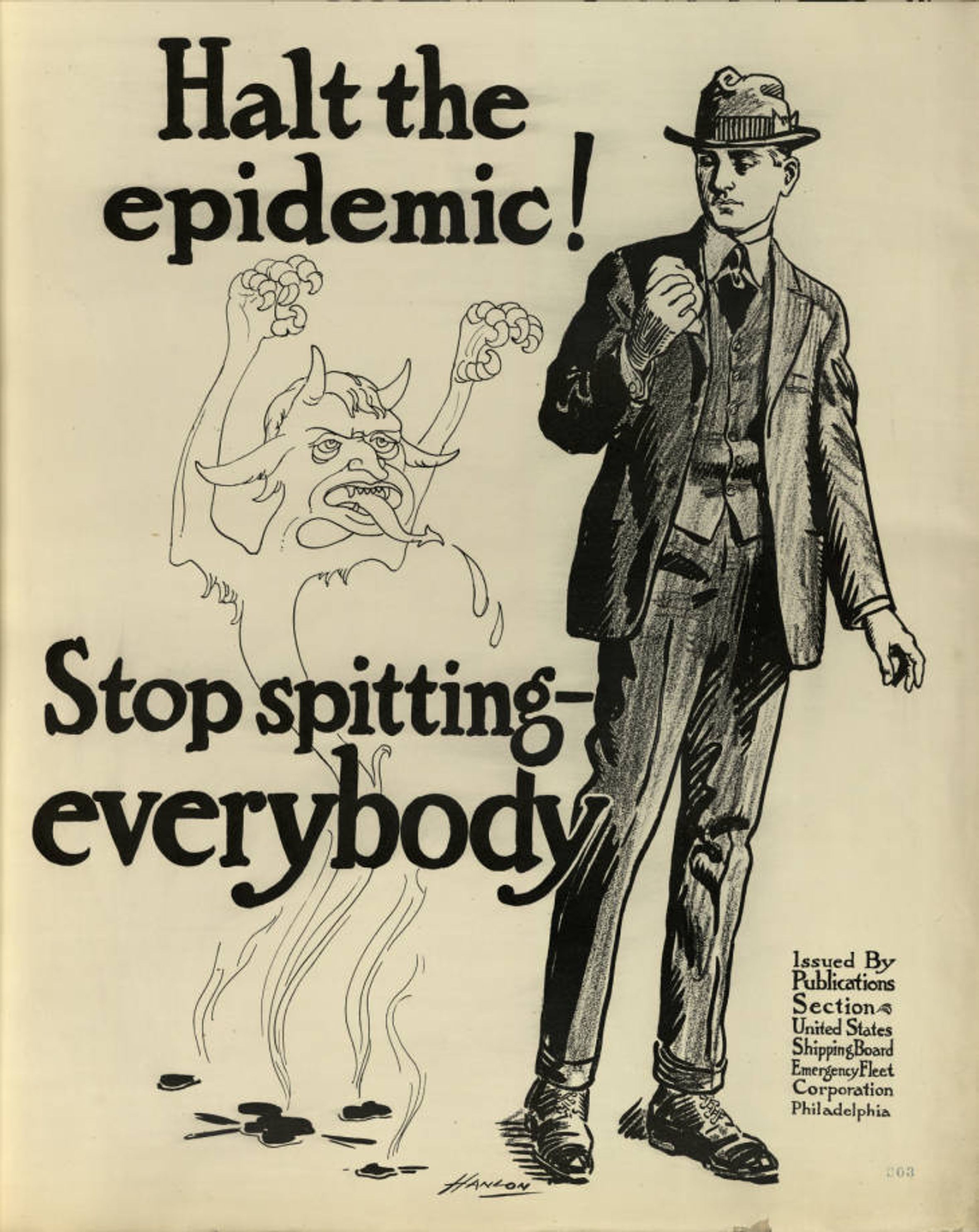
United States Shipping Board Emergency Fleet Corporation - Publisher
1918
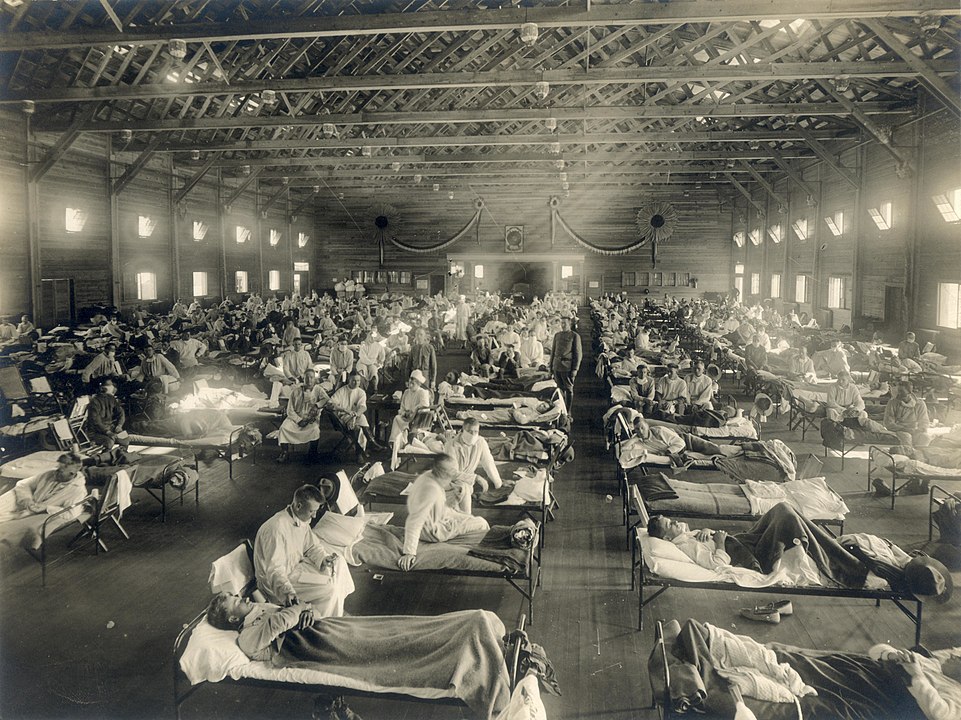
Of the 4,000 soldiers from Indiana that died during the war, there are 1,600 that are listed as having died of influenza or pneumonia. This information is difficult to assess, as gas poisoning also frequently caused complications resulting in death by pneumonia.
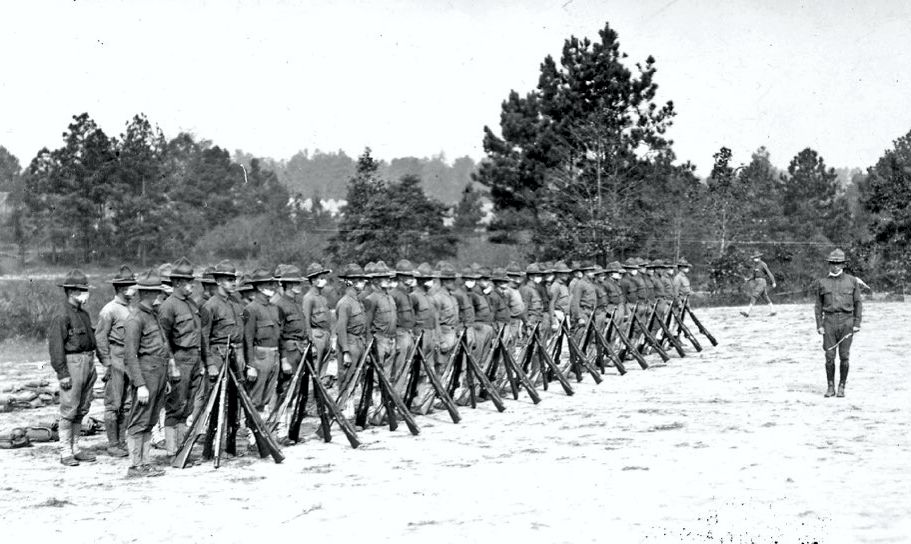
Soldiers in formation at Camp Gordon, Georgia, with flu masks
National Archives Photo Ch 8, Sec 5
"Booknotes,
Stories from American History"
by Brian Lamb, founder of C-SPAN
Tippecanoe County, Indiana,
The book includes an article on the 1918 Influenza Pandemic by Gina Kolata, science reporter for the New York Times and author of “Flu: The Story of the Great Influenza Pandemic of 1918 and the Search for the Virus That Caused It”, published in 1999 by Farrar, Straus & Giroux:
“The Influenza Pandemic of 1918 was the worst infectious disease epidemic in recorded history. It killed so many people that if something like that if it happened today, it would kill more people than the top ten killers wrapped together - 1.5 million Americans or so.
Historians keep ratcheting upward the number of people who died worldwide. People now think that 40 million is an underestimate, which used to be the median estimate. Most recently there was a meeting of historians and other people who were interested in this flu in South Africa. They think that the true number of deaths worldwide was closer to 100 million and that possibly 20 million died on the Indian subcontinent alone. With the 1918 flu, people would die very quickly, almost overnight, because their lungs would fill with fluid. You would have a young person who would start to feel sick and, within hours or a day or so, would be gasping breath. Their skin would turn dark because their blood wasn’t getting enough oxygen. One person described it as mahogany spots on the cheekbones, and then the dark color started to spread.”
The armistice ending World War 1 was signed in 1919. The year before the War ended, 1918, saw not only a huge number of war casualties but was also the year of one of the deadliest viruses in history. In September 1918, Dr. Victor Vaughn, acting surgeon general of the army, received orders to proceed to Camp Devens near Boston, where the deadly strain of influenza first appeared in America. On the day he arrived, sixty-three men died from the virus. In October alone, 195,000 Americans fell victim to influenza and 1.5 million would die by the time the pandemic ran its course.
Lillian Dell Seneff. Army Nurse Corps,
Orange County, Indiana
“Dreadful to see men dying with flu. How happy the boys were to be back, some with fingers gone; some legs and arms; some, minds gone.
Thaddeus Reamy Brenton, Seaman, US Navy, Ripley County, Indiana, wrote of his experiences:
"Having been kept on station duty during my period of enlistment there is very little of interest in my record, but the great epidemic of Spanish Influenza in the camps of this country is bound to rank as one of the horrors of the World War. No one is so well aware of this fact as the men in the hospital service.
The thing seemed to seize the great naval station overnight; coming all at once, unexpected and unannounced. Naturally, they were not prepared. All the sick bays filled, the base hospital filled to the doors and numerous barracks were transformed into wards. The illness seized hundreds, thousands at once; every available well boy was detailed as a nurse or put to work with the dead in the morgue, which was filled to overflowing. Every day freight cars, many of them, left the main hospital with their sad, silent loads. The nearly cured boys returned to find their dearest friends "gone west." The yellow flag flew over the station for six long weeks; and on the first Liberty, after the quarantine was removed, how many, many vacant lines on the Liberty list. They passed from the glories of the battlefield, but they are cherished memories just the same. "They also serve who only stand and wait." They answered God's call from under the Stars and Stripes."
Emma Mary Stoll, Army Nurse Corps, Blackford County, Indiana (served at Camp Dix, New Jersey)
"The horror of the flu epidemic, where 800 patients were admitted in the receiving ward in a single day. The Sand Storm Division, made up of strapping cowboys from New Mexico, wiped out by the flu... Horrible scenes in the orthopedic department where I assisted with the operations... Amusing incident: a nurse riding within Army official's chauffeur discovered by his dodging about from one road to another, that they were in a government car and the driver was trying to elude the numerous MPs.... The housing situation for nurses was terrible. It was impossible to get all supplies under the conditions. The hospital building, even the porches, were all filled with flu cases.... I was assigned to night duty in charge of two buildings with 104 white and colored patients. Medical officers were on 12-hour shifts.... During my stay in the camp proper, I felt like I was in another world."
Warren David Calvin, Physician, 1st Lt., Allen County, Indiana
“Was a member of the first draft examination Board, as commission in medical reserve Corps, April 1916. Transferred to serve in Base Hospitals in Texas
Experience: Reduced weight due to increased exercise physical improvement until the influenza epidemic; had influenza a mild form but continued at duties, was somewhat fatigued after epidemic due to extra work and effects of influenza.
Commissioned Captain after Armistice but commission not accepted.
Anderson Herald, Sunday, October 20, 1918, pg. 1:
WILL CLOSE SEVERAL PLACES
County Health Commissioner Owen could put a ban on pool rooms, saloons, bowling alleys here.
ARMY CAMPS IMPROVE
Influenza increases among civilians from coast-to-coast - Capital has many deaths
Pool rooms, near-beer salons, probably bowling alleys, and cigar stores in Anderson will be ordered by tomorrow to close during the remainder of the state health ban on places were persons congregate and linger, according to Dr. T. S. Owens, of Elwood, health Commissioner of Madison County.
Dr. Owens was surprised yesterday, he said when he learned that the city Board of Health had not close the places he will order closed. Dr. Owen said that the state health board order meant for the pool rooms, so-called dry saloons, and other places he mentioned should be closed. He also said they were closed in Elwood and Alexandria when the order was the first issue. Dr. Owen said he would direct the closing of these places by order to the Secretary of the city Board of Health, Dr. Jay Long, and would expect the order executed at once.
Dr. Owen said that despite the reports issued in Anderson, there is much influenza and pneumonia in Madison County and while Anderson has not yet been severely stricken, Anderson, like other cities and towns in Indiana, should take no chances and would have to adopt the precautionary measures prescribed by the state Board of Health.
Dr. Owens is a presiding health officer in Madison County. The state board issuing orders to him and he directs various health boards of the cities and towns in Madison County.
Maude Josephine Tanzy, American Red Cross, Warrick County, Indiana
" A storm in our crossing cannot be pictured - we were exactly 3 weeks en route before we landed at Le Havre. More than one-third of the passenger suffered from the Flu. we were struck by an equinoctial storm lasting four days and three nights during which time we lost our convoy. Drifted off our course and put in at Falmouth, England, to take off nine stretcher patients not recovered from Flu, shore patrol came alongside, and after calling out as to where the boat, was bound, etc., he, of course, asked what cargo and the answer went back 'frozen beef'. From that time I kept my sense of humor which saved me many a sleepless night"
Glenn Trester, US Navy, Goldstar, Decatur County, Indiana
Local Liberty Guards act as Pallbearers and form Squad Marching to Cemetery.
A military funeral for Glenn Dressler, 17, a local boy who died Saturday morning at Great Lakes Naval training station of Spanish influenza was planned for 4:00 this afternoon with the local Liberty Guards in charge of the ceremony. Short funeral services were held at the Schulz undertaking parlors, conducted by Rev. C. B. Jones of the Baptist Church, of which church and Sunday school he was a faithful member.
The liberty guards act as pallbearers and planned to have a firing squad to come with the body to the Cemetery. No arrangements were made for the firing of the customary salute. It was also arranged to have a sailor sound the bugle call. The Liberty Guards were under the charge of Lt. Harbison.
Dressler enlisted in the Navy last April. His death came as a shock to many friends. The body arrived last night."
Amelia B. Tauer, Army Nurse Corps, Wayne County, Indiana
"Influenza was an epidemic force. There was a shortage of nurses due to the epidemic. The wards were filled, and many soldiers were ill in their quarters. I was given charge of the pneumonia wing and did much overtime work, for every day (we) saw nurses coming down with influenza and those who were well kept on so all patients could have care. We, nurses, felt it our patriotic duty to give of ourselves, our time, our knowledge, as our part in winning for the nation that which was to bring World Peace."
Everett Leon Schmedel, Medical Corps, Marion County, Indiana
“About September 23, 1918, there were more than or approximately 72,000 at Camp Taylor. About this time influenza ravaged the Camp. All the patients were housed and were given prompt medical treatment. All of the medical detachment men at the base hospital were moved into tents to make room for the patients. We remained in these tents until the epidemic was practically over.
Tony Edward Hunter, MD, AEF, Ripley County, Indiana
“Service: Was on hospital staff of 149th Infantry as ward surgeon. Because of this position, he was overworked when over 600 cases of influenza and pneumonia developed in his regiment on April 19, 1918, and so was unable to combat the disease when he himself was attacked.
“Lt. Hunter was the first officer lost from the 38th Division. His body was brought home and buried in Cliff Hill Cemetery, Versailles, Indiana. The 149th spent three weeks on the rifle range in January 1918, enduring much inclement weather due to the severest winter on record in the United States.
“Lt. Hunter was the officer at Camp Shelby to plan decorations for the hospital grounds and personally gave much time to planning and putting out shrubs and flowers, securing many of these from friends in New Orleans.”
Bessie B. Thomas, Army Nurse Corps, Vigo County, Indiana
Diagnosed with "Pulmonary tuberculosis as a result of having Flu while in service"
Lillian Van Osdol, Army Nurse Corps Ohio County, Indiana
Served at General Hospital one, in New York. After her discharge, she had charge of an Emergency Hospital in the Elks Home, Greensburg, Indiana during the flu epidemic. Also had charge of flu cases at Indiana University fraternity house.
Robert Brook, Private, Goldstar, Marion County, Indiana
Son of Luke and Martha Brook, 2035 Langley Avenue, Indianapolis. Drafted July, 1918.
“Served in camp at Valparaiso, Indiana (University Camp), also at St. Louis Missouri, sent from there to Fort Bliss Texas. From there to hospital in Denver, Colorado, where he died from tuberculosis caused from influenza on the 18th of March, 1919.
“Belonged to Indiana infantry, could not tell me the number”
(This soldier was omitted from the “Gold Star” book of Indiana. Record found in Marion County in the World War, Soldiers Records, Indiana State Library, June 9, 1924, Accession # I940.3772.M3413 (Vol 1-E;)
Fighting influenza in the US Army
Indiana War Memorial Photo

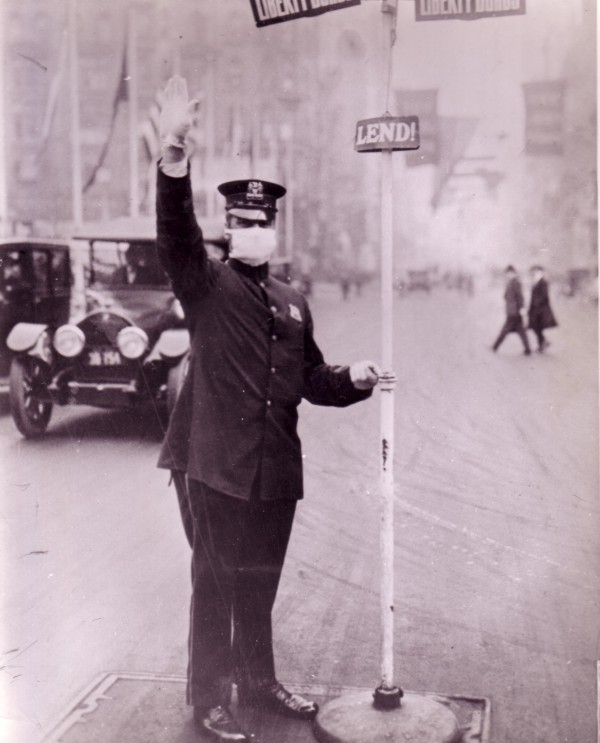
Masks for protection against influenza.
Traffic cop in New York City wearing the gauze mask.
National Archives Photo, C713040 Group 64,
Indiana War Memorial
The first wave of the flu presented typical symptoms. The second wave was deadly. Dark mahogany spots appeared over the cheekbones and then spread coloring the entire face first blue and then black from the lack of oxygen in the bloodstream. The black color would spread throughout the body and death would follow from the lungs filling with fluid.
Van Sykes, Pfc., 309th Field Signal Battalion, Vanderburg County, Indiana
Co. A, of the 309th Field Signal Battalion, was originally of the 22nd Field Service Battalion, a signal reserve unit, organized at Minneapolis, Minnesota of mostly Minnesota boys. Ordered to Camp Taylor, Kentucky, and attached to the 84th Div. in the fall of 1917, this Co. was made a part of the 309th Field service Battalion and was filled up at Camps Taylor and Sherman with a few Indiana and Kentucky boys and went overseas as a unit. After a few weeks of training in southern France, the Battalion moved to the 20th Signal Corps replacement Camp at Couer de Cheverny, leaving the 84th Div. While at Neuvic, in southern France our Major, Frank L. Shuman of Bismarck, North Dakota was taken sick with flu and died shortly afterward in the hospital at Perrigeux; with the exception of a boy from Co. C., whose name I do not recall, I believe these were the only casualties the Battalion suffered as a unit.
At Couer de Cheverny, the Battalion was used to replace combat units at the front. Twenty-five telegraph operators, including myself, were assigned from Co. A. to join the 88th Div. which was at that time in reserve near Metz. We remained with this organization, the 313th Field Service Battalion of the 88th Div. until it was demobilized.
Wilbur W Linder, US Navy, HMS Leinster, Vanderburg County, Indiana
"I made the trip to London and had a fine time-saw and learned a lot. The party on that leave arrived there safely, but coming back but was torpedoed twice, the explosion being in the post office and the engine rooms. 600 people were drowned and 480 survived. One of the boys with us lost his mind and the rest of us aren't any too well balanced as a result of our experiences. Several died later. It was cold and stormy and we were crossing the Irish Sea. We were taken to Cork, where I had time to dry my clothes. I wrote you a short letter.
"The influenza was raging around here then and some died from it on shipboard. I can't figure out how it spread all over the world so quickly. It sure was terrible.
"At present, I am in the Castletown in Ireland and our ship is anchored at Bantry Bay. On the 28th of this month, we go to meet the Royal Navy. We will go with them for a while and then go back to America. The Royal Navy, or fleet, is believed to be along the Italian coast at present. I certainly want to see Italy. I have already been to England, Wales, and Ireland and now for Italy and then America."
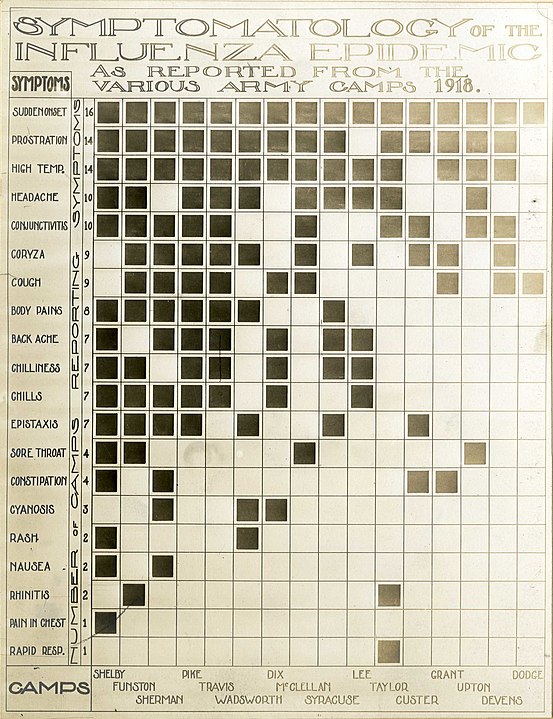
US Army symptomology of the flu chart
Wikipedia
By Otis Historical Archives nat'l Museum of Health & medicine (OTIS Archive 1)
Symptoms reported:
- spontaneous mouth or nosebleeds
- peculiar smell
- hair falling out
- blurred vision
- loss of color vision
- delirium
- dizziness
- insomnia
Death usually occurred from subsequent bacterial pneumonia, respiratory failure caused by influenza.
The flu caused a strong immune response (cytokine storm) which meant younger, healthier people with good immune systems were the most vulnerable.